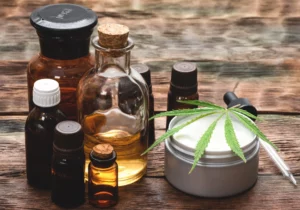It was long believed that the “high” associated with cannabis was caused by a flood of dopamine released by the consumption of tetrahydrocannabinol (THC). This theory has been largely discredited, though it’s still believed that cannabinoid receptors in the body are closely linked to the body’s reward system. Cannabis, when compared to drugs like amphetamines and cocaine, only produces a moderate amount of dopamine. THC does, however, work on the same receptors as our bodies’ naturally occurring, pleasure-inducing endocannabinoid, anandamide.
FOLLOW US ON FACEBOOK & INSTAGRAM
Cannabis’s Connection to Anandamide, the Feel-Good Molecule
Anandamide is a neurotransmitter that’s believed to be the true cause of the euphoria related to cannabis. Anandamide, which is one of the body’s natural endocannabinoids, is known to produce joy and happiness. It also plays a role in memory, motivation, pain, appetite and fertility. It’s the binding of anandamide with the CB1 receptor that produces the “feel good” effect that is similar to that associated with cannabis usage.
Meanwhile, a study published in 2014 in the journal Transitional Medicine found that anandamide can even affect the growth of breast cancer cells. The study found that anandamide inhibits pro-angiogenic factors, which provides its anti-tumor efficacy. Anandamide, which is very fragile, also has anti-anxiety and anti-depressant properties.
THC in cannabis works on the same receptors that anandamide does, allowing it to stimulate happy and euphoric feelings in a similar way. THC works to supplement the body’s internally produced anandamide. This is why it can help boost people’s moods. Cannabis, however, doesn’t always have joy-producing effects on people. Some folks may experience negative effects from using cannabis—this effect is also linked to anandamide.
Why Do Some Folks Feel Anxious After Using Cannabis?
FAAH, also known as fatty acid amide hydrolase, is a naturally occurring molecule in the body that deactivates anandamide. People are genetically predisposed to produce more or less FAAH, which changes the levels of anandamide in their body.
Folks with less FAAH, who naturally have more anandamide, tend to have more anxiety-producing effects from cannabis. This is because their increased levels of anandamide quicken the biphasic effects of cannabis. Since they already have higher levels of anandamide binding to their CB1 receptors, they can easily be overwhelmed by smaller levels of THC, which binds to the same receptors.
RELATED: WHEN MARIJUANA MAKES YOU FEEL ANXIOUS
Anandamide, Chocolate and the Runner’s High
Cannabis isn’t the only thing that can stimulate anandamide and boost your mood. Chocolate, which contains theobromine, is believed to cause the brain to produce more anandamide. Theobromine is a relaxant that is related to caffeine that is believed to stimulate anandamide production in the body. Chocolate also contains molecules that slow the breakdown of anandamide. The stimulation of anandamide is believed to be one of the main reasons why chocolate is one of the most commonly craved foods. Other foods, including truffles, parsley, tea and celery, also contain anandamide or stimulate its production. Exercise also can produce anandamide. The “runner’s high” associated with working out is actually related to increased anandamide production, rather than just by a flood of endorphins as previously thought.
If you’re new to cannabis and want to learn more, take a look at our Cannabis 101 post. HelloMD can help you get your medical marijuana recommendation; it’s 100% online, private and efficient.






